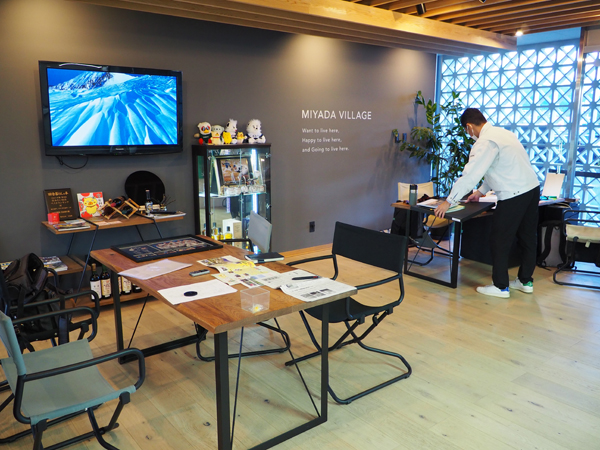Series ”Visiting the village” in search of the key to regional revitalization 6 Miyada Village, Nagano Prefecture

Miyada Village, located in the southern part of Nagano Prefecture, has an ideal compact village. Generally speaking, when you think of a village, you have the image of a quiet, empty place, but Miyada Village is a small area within a radius of about 3 kilometers and has all the facilities necessary for daily life, such as a supermarket, convenience stores, restaurants, and a hospital. The area consistently ranks high in indicators published by the media, such as ”Ranking of the Best Rural Areas to Live in”.
Village Mayor Yasuhiko Odagiri focuses on migration measures and child-rearing support under the theme of ”a village where I want to live, am glad to live, and want to continue living”.
Specifically, ① Creating Miyada Village full of vitality – Promoting industry through coexistence with industries and securing a population that can maintain the village’s vitality, ② Aiming to be the best in Japan in child-rearing support – Creating a village where children can shine, ③Promoting welfare – Promoting welfare from diverse standpoints. Building a village that brings warmth to the villagers, ④ Creating a safe, secure and peaceful village – Promoting disaster prevention measures and creating a safe community, ⑤ Utilizing women’s wisdom and power in village administration – Bringing women’s voices to village administration, ⑥ Promoting collaboration. Promotion of village development.
About 10 years ago, they appointed a dedicated person to focus on immigration policy. They provide one-stop immigration consultation services. They will also work to raise awareness of Miyada Village by holding migration consultation meetings across the country with the help of the private sector.
The current population is approximately 8,800. At its peak, there were about 9,200 people. Although the number has not decreased significantly, they would like to maintain the number of 9,000 people.
Yasukuni Hoshina, chief of the Miyata Village Hall’s Future Creation Division, who is in charge of migration policy, said, ”Manufacturing is the main industry in our village, and Ina City and Komagane City are within commuting distance, so we have a good place to work and infrastructure. There are many young people living in the village, and the aging rate is low.The child population rate is in the top 3-4 in the prefecture.In order to maintain such a vibrant village, it is necessary to secure a certain level of population. “With this in mind, we are working on migration measures and childcare suppor”.
Regarding childcare support, we provide seamless support for each phase, from pregnancy to high school graduation.
Taxes are, of course, the source of funding for childcare support, but if the number of immigrants increases and the number of villagers can be maintained, tax revenues will become stable.
Miyata Village receives 300 inquiries about immigration every year. Of these, only about 60 people actually emigrate.
”People who want to immigrate are evenly split between people from within Nagano Prefecture and people from outside the prefecture.Since the coronavirus pandemic, the characteristics of people who want to immigrate have changed.In the past, there were many families with children, but in recent years, people who want to immigrate are more likely to be working from home. The number of households and single people deciding to move to Japan is increasing” (Mr. Hoshina).
In fact, Miyada Village has good access to Tokyo. You can go to Shinjuku by one express bus. The journey takes just over three and a half hours, and there are 20 trains a day. There are also 20 buses a day to Nagoya.
For example, if you commute to Tokyo a few times a month and telework from home the rest of the month, Miyada Village is a good area to live in.
Although Miyada Village has a relatively young population and a well-developed infrastructure, it is said to be a little behind when it comes to digitalization.
Village Mayor Odagiri commented, ”We are aware that there are many issues to be addressed in DX. DX has not progressed yet, but we would like to improve resident services by proactively moving forward”.
By improving the efficiency of resident services through DX, the company hopes to introduce ”no-visit, no-wait, no-fill-in counters” and online reservations for public facilities starting next year.
Villagers are reportedly calling for administrative services to be made compatible with SNS and for the village to become cashless.
Mr. Hoshina said, ”We want to advance DX starting with services that residents can easily use.” On the other hand, he said, ”There are various digital services available, but in small villages, employees have to be in charge of multiple services, which results in a heavy burden.It would be great if we could save labor in that area as well…” .
A future issue is securing secondary transportation.
There are no circulation buses running in Miyada Village. As it is a compact village, it is not currently inconvenient, but it will become necessary as the population ages.
”Currently, we are distributing taxi tickets to elderly villagers and asking them to use them, but these cannot be used by students and others to commute.Even in small villages, secondary transportation and people who have difficulty shopping will become a big issue in the future. We would like to proceed with the study, keeping in mind the introduction of self-driving buses,” said Hoshina.
